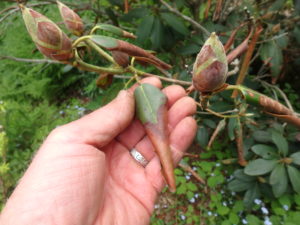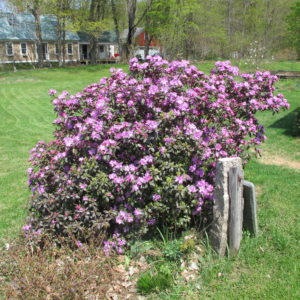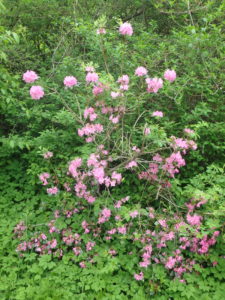What Happened to Our Rhododendrons?
Rhododendrons throughout New England are looking awful! It is common for “rhodies” to get shriveled leaves during the winter, but they normally recover in spring. Those shriveled leaves occur when warm winter days allow moisture to be given off when the ground is frozen solid – and thus unable to re-hydrate the leaves. Normally they look good again as soon as the ground thaws.
I’ve been getting e-mail from readers asking what happened this year, so I called an expert to learn more. Dr. Cheryl Smith is a plant pathologist at the University of New Hampshire in Durham.
Dr. Smith said that the winter damage this year was the worst she had seen in decades. Not only were rhododendrons damaged, she said, but also cherries, plums, Christmas trees, boxwoods, junipers, spruce, raspberries and blueberries. Yikes.
First, the good news: the damage you are seeing is not due to a pathogen. This is not a disease that is damaging your plants. And most plants will recover fully, given time. But you must have patience. Please don’t get out the chain saw and cut away everything that’s looking bad.
Most of the damage is due to fluctuating temperatures, said Dr. Smith. Usually in the fall evergreen trees like rhododendrons harden off their leaves as the temperatures slowly descend. This past fall was a warm one, with temperatures in the sixties in December, followed by low temperatures in January. Then in February the temperatures again went into the sixties for a day or two, sending signals to plants that spring was on the way. But then it dropped below zero within a week.
Throughout the winter there were high winds, and repeated freeze-thaw cycles. But the ground was frozen and during the thaw cycles plants could not take up water to replace that lost due to respiration.
So what should you do now? You can test any given twig by scratching it with your thumbnail. If you see green, the branch is still alive. If a branch is brittle and brown, and shows no green when you scratch it, the branch is dead and should be removed. Branches with brown leaves will eventually send out new leaves.
I recently visited a site where I had overseen the installation of some rhododendrons last fall. Some looked much worse than others – even though they are growing in close proximity.
I wanted the plants to look better, so I removed dead leaves, or leaves that were mostly brown. Some came off with a gently tug, others needed a snip from my pruners. Obviously I wouldn’t do that if the shrub was 20 years old, huge, and badly damaged, as it would take too long. Mother Nature will eventually replace the leaves.
Many, perhaps most, of the flower buds on those rhodies were damaged and will not bloom this year. On the other hand, some rhododendron varieties are tougher than others. The most common rhododendron variety, the PJM, is tough as nails.
The PJM is a pink-purple color and is planted everywhere. It was developed at Weston Nurseries by Edmond Mezitt, and named after his father Peter J. Mezitt (his initials = PJM) when it first bloomed in 1945. Apparently nurseryman Peter Mezitt gave $50 to some friends traveling in China in 1939 to collect some nice seedlings for him.
Edmond collected pollen on a paint brush from one very nice rhododendron of a species known as Rhododendron dauricum, and used it to pollinate a Rhododendron carolinianum which they were using as seed stock. He saved seeds, and planted them. The first hybrid cross bloomed beautifully when it was just 6 or 8 inches tall, and it was evident right away that this hybrid was special.
The parent plants of the PJM are still alive and well in front of the offices of Weston Nursery, and Wayne Mezitt (of the third generation of Mezitts in the nursery business) showed them to me when I visited Weston Nurseries some years ago.
The “mother’ plant of the PJM is a cultivar known as ‘Olga’, named after his grandmother. Wayne gave me an Olga about 15 years ago, it has done well, and it showed no damage this winter. It is currently finishing its bloom cycle. It is much pinker than the PJM.
Gardening is the slowest of the performing arts. You plant a seed or a seedling and wait to see how it performs. Wayne Mezitt told me that you can hybridize thousands of plants and grow them out before you get something special. I guess that’s why I don’t have any plants named after me!
Henry is a 20 year veteran of the UNH Master Gardener program and a lifetime organic gardener. His e-mail is henry.homeyer@comcast.net. He is the author of 4 gardening books.





